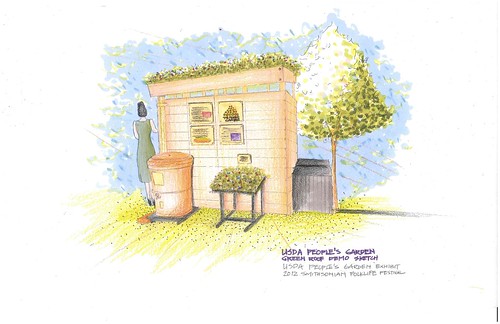
In my first interview I talked about the design and construction of the People’s Garden shed located at the Smithsonian Folklife Festival and the importance of using reclaimed materials. The shed also includes a variety of environmentally-friendly features such as a green roof and rain barrel. Visitors are asking how a green roof and rain barrel are built, and what environmental benefits they provide. I talked with Edward Murtagh, Sustainable Operations Manager in USDA’s Office of Operations about the addition of a green roof and rain barrel to the shed.
How do you build a roof to accommodate a green roof?
This green roof weighs 30 lbs per square foot with about 4 inches of soil, so the structure needs to be able to support that extra weight. There needs to be an edge around the roof to hold the soil and plants in. You don’t need shingles on the roof because the garden replaces that.
Is it possible to modify an already built roof to add a green roof?
Yes, you can add a green roof to an existing roof. On the roofs of most buildings, there are rocks that help protect the roof and keep water out. In order to add a green roof, you have to remove those rocks to take weight off of the roof. This weight will be replaced with soil and plants. It is necessary to take off the rocks because otherwise there would be too much weight for the roof to handle.
What types of plants normally go in a green roof?
The environment on many roofs is very harsh (almost desert-like) so the plants need to be able to withstand extreme conditions. It can get really dry due to the shallowness of the growing medium so whatever plants you grow should be specially selected for these conditions. It’s important to know that the growing medium used is engineered and may not include soil. The green roof on this shed is planted with a combination of sedums that form a colorful carpet.
What message do you hope to send about green roofs during the festival?
Storm water runoff is a major problem. Green roofs can capture and hold rainwater that would otherwise run down streets. I want people to know that landscapes should do more than look pretty. For example, green roofs have great benefits. They cool the building they’re on top of and they save energy and water, all while looking beautiful.
What benefits does a rain barrel provide?
A rain barrel sits next to our shed to collect and store rainwater that would otherwise pour from the roof and rush off to storm drains and streams. Rain barrels make it possible for gardeners to irrigate plants at no cost instead of using water from the tap or faucet. By setting up a rain barrel, you can save money and water. For example, 660 gallons of water can be collected if it rains one inch on a thousand square foot roof.
Can you use any kind of container for your rain barrel?
It is easiest to get a pre-made barrel to prevent leaks and mosquitoes. It would be hard to make your own barrel that was tightly sealed. In my opinion, trashcans are not the best container to use because they aren’t intended for this purpose.
How do you set up a rain barrel?
There is a lot of good information available on using and constructing rain barrels. Folks should contact their local Cooperative Extension office at www.extension.org for assistance.
